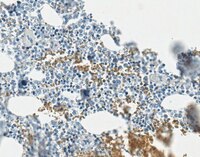Fibrocytes in the fibrotic lung: altered phenotype detected by flow cytometry.
Reese, C; Lee, R; Bonner, M; Perry, B; Heywood, J; Silver, RM; Tourkina, E; Visconti, RP; Hoffman, S
Frontiers in pharmacology
5
141
2014
Show Abstract
Fibrocytes are bone marrow hematopoietic-derived cells that also express a mesenchymal cell marker (commonly collagen I) and participate in fibrotic diseases of multiple organs. Given their origin, they or their precursors must be circulating cells before recruitment into target tissues. While most previous studies focused on circulating fibrocytes, here we focus on the fibrocyte phenotype in fibrotic tissue. The study's relevance to human disease is heightened by use of a model in which bleomycin is delivered systemically, recapitulating several features of human scleroderma including multi-organ fibrosis not observed when bleomycin is delivered directly into the lungs. Using flow cytometry, we find in the fibrotic lung a large population of CD45(high) fibrocytes (called Region I) rarely found in vehicle-treated control mice. A second population of CD45+ fibrocytes (called Region II) is observed in both control and fibrotic lung. The level of CD45 in circulating fibrocytes is far lower than in either Region I or II lung fibrocytes. The chemokine receptors CXCR4 and CCR5 are expressed at higher levels in Region I than in Region II and are present at very low levels in all other lung cells including CD45+/collagen I- leucocytes. The collagen chaperone HSP47 is present at similar high levels in both Regions I and II, but at a higher level in fibrotic lung than in control lung. There is also a major population of HSP47(high)/CD45- cells in fibrotic lung not present in control lung. CD44 is present at higher levels in Region I than in Region II and at much lower levels in all other cells including CD45+/collagen I- leucocytes. When lung fibrosis is inhibited by restoring caveolin-1 activity using a caveolin-1 scaffolding domain peptide (CSD), a strong correlation is observed between fibrocyte number and fibrosis score. In summary, the distinctive phenotype of fibrotic lung fibrocytes suggests that fibrocyte differentiation occurs primarily within the target organ. | 24999331
 |
No donor age effect of human serum on collagen synthesis signaling and cell proliferation of human tendon fibroblasts.
Bayer, ML; Schjerling, P; Biskup, E; Herchenhan, A; Heinemeier, KM; Doessing, S; Krogsgaard, M; Kjaer, M
Mechanisms of ageing and development
133
246-54
2012
Show Abstract
The aging process of tendon tissue is associated with decreased collagen content and increased risk for injuries. An essential factor in tendon physiology is transforming growth factor-β1 (TGF-β1), which is presumed to be reduced systemically with advanced age. The aim of this study was to investigate whether human serum from elderly donors would have an inhibiting effect on the expression of collagen and collagen-related genes as well as on cell proliferative capacity in tendon cells from young individuals. There was no difference in systemic TGF-β1 levels in serum obtained from young and elderly donors, and we found no difference in collagen expression when cells were subjected to human serum from elderly versus young donors. In addition, tendon cell proliferation was similar when culture medium was supplemented with serum of different donor age. These findings suggest that factors such as the cell intrinsic capacity or the tissue-specific environment rather than systemic circulating factors are important for functional capacity throughout life in human tendon cells. | 22395123
 |
Circulating fibrocytes are increased in children and young adults with pulmonary hypertension.
Yeager, ME; Nguyen, CM; Belchenko, DD; Colvin, KL; Takatsuki, S; Ivy, DD; Stenmark, KR
The European respiratory journal
39
104-11
2012
Show Abstract
Chronic inflammation is an important component of the fibroproliferative changes that characterise pulmonary hypertensive vasculopathy. Fibrocytes contribute to tissue remodelling in settings of chronic inflammation, including animal models of pulmonary hypertension (PH). We sought to determine whether circulating fibrocytes were increased in children and young adults with PH. 26 individuals with PH and 10 with normal cardiac anatomy were studied. Fresh blood was analysed by flow cytometry for fibrocytes expressing CD45 and procollagen. Fibrocyte numbers were correlated to clinical and haemodynamic parameters, and circulating CC chemokine ligand (CCL)2 and CXC chemokine ligand (CXCL)12 levels. We found an enrichment of circulating fibrocytes among those with PH. No differences in fibrocytes were observed among those with idiopathic versus secondary PH. Higher fibrocytes correlated to increasing mean pulmonary artery pressure and age, but not to length or type of treatment. Immunofluorescence analysis confirmed flow sorting specificity. Differences in plasma levels of CCL2 or CXCL12, which could mobilise fibrocytes from the bone marrow, were not found. We conclude that circulating fibrocytes are significantly increased in individuals with PH compared with controls. We speculate that these cells might play important roles in vascular remodelling in children and young adults with pulmonary hypertension. | 21700605
 |
Spatiotemporal coupling of focal extracellular matrix degradation and reconstruction in the menstrual human endometrium.
Gaide Chevronnay, HP; Galant, C; Lemoine, P; Courtoy, PJ; Marbaix, E; Henriet, P
Endocrinology
150
5094-105
2009
Show Abstract
Coupling of focal degradation and renewal of the functional layer of menstrual endometrium is a key event of the female reproductive biology. The precise mechanisms by which the various endometrial cell populations control extracellular matrix (ECM) degradation in the functionalis while preserving the basalis and the respective contribution of basalis and functionalis in endometrium regeneration are still unclear. We therefore compared the transcriptome of stromal and glandular cells isolated by laser capture microdissection from the basalis as well as degraded and preserved areas of the functionalis in menstrual endometria. Data were validated by in situ hybridization. Expression profile of selected genes was further analyzed throughout the menstrual cycle, and their response to ovarian steroids withdrawal was studied in a mouse xenograft model. Immunohistochemistry confirmed the results at the protein level. Algorithms for sample clustering segregated biological samples according to cell type and tissue depth, indicating distinct gene expression profiles. Pairwise comparisons identified the greatest numbers of differentially expressed genes in the lysed functionalis when compared with the basalis. Strikingly, in addition to genes products associated with tissue degradation (matrix metalloproteinase and plasmin systems) and apoptosis, superficial lysed stroma was enriched in gene products associated with ECM biosynthesis (collagens and their processing enzymes). These results support the hypothesis that fragments of the functionalis participate in endometrial regeneration during late menstruation. Moreover, menstrual reflux of lysed fragments overexpressing ECM components and adhesion molecules could easily facilitate implantation of endometriotic lesions. | 19819954
 |
Cruciate ligament laxity and femoral intercondylar notch narrowing in early-stage knee osteoarthritis.
Quasnichka, HL; Anderson-MacKenzie, JM; Tarlton, JF; Sims, TJ; Billingham, ME; Bailey, AJ
Arthritis and rheumatism
52
3100-9
2005
Show Abstract
The influence of the cruciate ligaments in spontaneous osteoarthritis (OA) is not understood, although ligament rupture is known to cause secondary OA. Additionally, femoral notch narrowing at the anterior cruciate ligament (ACL) insertion site is associated with disease severity, but it is unknown whether ligament deterioration precedes or follows osteophyte formation. We examined cruciate ligament mechanics and metabolism and the intercondylar notch width in OA-prone Dunkin-Hartley (DH) guinea pigs at ages up to and including the age at OA onset (24 weeks), and compared the data with those in age-matched controls (Bristol strain 2 [BS2] guinea pigs).Guinea pigs were assessed at 3, 6, 9, 12, 16, 20, 24, and 36 weeks of age. ACLs were mechanically tested, and the intercondylar notch width index (NWI) was determined. Cruciate ligament metabolism was determined by measuring the following markers of collagen turnover: matrix metalloproteinase 2 (MMP-2), tissue inhibitor of metalloproteinases 2, C-terminal type I procollagen propeptide (PICP), and the immature collagen-derived crosslink dihydroxylysinonorleucine (DHLNL).DH guinea pigs had significantly laxer ACLs than did BS2 guinea pigs, at 12, 16, and 24 weeks. We observed elevated levels of pro and active MMP-2, PICP, and DHLNL in the cruciate ligaments of DH animals at most ages, compared with BS2 guinea pigs. The NWI in DH animals was significantly lower than that in BS2 guinea pigs at 24 and 36 weeks.In DH guinea pigs, laxer ACLs, which are associated with increased collagen turnover, may cause joint instability and predispose these animals to the early onset of OA. Decreased intercondylar notch width in the DH animals indicates that bone remodeling at the ACL insertion site is a response to elevated ACL laxity. | 16200589
 |
A monoclonal antibody to the carboxyterminal domain of procollagen type I visualizes collagen-synthesizing fibroblasts. Detection of an altered fibroblast phenotype in lungs of patients with pulmonary fibrosis.
McDonald, JA; Broekelmann, TJ; Matheke, ML; Crouch, E; Koo, M; Kuhn, C
The Journal of clinical investigation
78
1237-44
1986
Show Abstract
Excessive collagen deposition plays a critical role in the development of fibrosis, and early or active fibrosis may be more susceptible to therapeutic intervention than later stages of scarring. However, at present there is no simple method for assessing the collagen-synthesizing and secreting activity of fibroblasts in human tissues. Type I procollagen carboxyterminal domains are proteolytically removed during collagen secretion. Thus, antibodies to these domains should stain fibroblasts synthesizing type I collagen but not extracellular collagen fibrils which could mask the signal from the cells. We developed and characterized a monoclonal antibody (Anti-pC) specific for the carboxyterminal propeptide of type I procollagen. To determine the relationship between Anti-pC staining and collagen synthesis, we stained embryonic and adult chicken tendon. Embryonic chick tendon fibroblasts actively synthesizing type I collagen stained heavily with Anti-pC, while quiescent adult tendon fibroblasts did not stain with Anti-pC. Wounded adult tendons developed fibroblasts that stained with Anti-pC at the wound site. Thus, Anti-pC specifically visualized fibroblasts actively synthesizing collagen. Lung biopsies from patients with fibrotic lung disease were stained with Anti-pC. Interstitial and intraalveolar fibroblasts in biopsies from patients with active fibrosis stained intensely with Anti-pC, while normal human lung was unstained. The absence of staining in normal lung supports the hypothesis that fibrosis is associated with an altered collagen-synthesizing phenotype of tissue fibroblasts. Anti-pC may provide a useful clinical tool for assessing fibrogenic activity at sites of tissue injury. | 3771795
 |



















